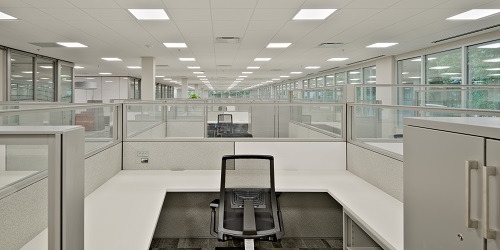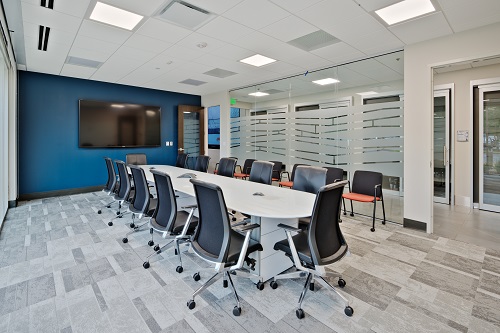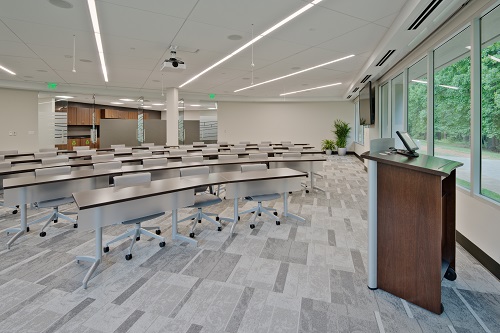Ingersoll Rand is committed to advancing quality of life by creating comfortable and efficient environments for its customers, and it has applied the company mission to its own building renovations at its North American Headquarters in Davidson, N.C.
Transforming Ingersoll Rand’s Building D commercial interior space, which comprises nearly 53,000 square feet across two levels, was achieved through efforts that included the installation of more energy-efficient lighting, a building automation system (BAS) with energy-saving control strategies, and ENERGY STAR® equipment and appliances.
 |
|
Ingersoll Rand’s renovation of its commercial interior space used low-emitting materials, including GE’s Lumination™ ET Series Recessed Troffers and Lumination BL Series LED Luminaires. (All photos courtesy of GE Lighting) |
“Ingersoll Rand is committed to making a more efficient use of resources a widely held value that becomes a central part of how its employees live and work every day; it is going beyond compliance, or simply ‘following the rule,’” said Gretchen Digby, director of global education and engagement for Ingersoll Rand’s Center for Energy Efficiency & Sustainability. “Ingersoll Rand wants to help its employees find ways to integrate the ideals and apply them to everything we do.”
The 215 employees at Building D now utilize offices and open floor work stations with access to numerous additional areas, including conference rooms of various sizes, copy/print rooms and break rooms. The updates to the space and the considerable work that went into it had efficiency in mind from the start—beginning with a full audit of the facility’s energy use, including lighting and HVAC systems.
 |
|
GE’s Lumination™ ET Series Recessed Troffers provide energy-efficient ambient lighting and will reduce power density by more than 36 percent. |
For example, 49 truckloads of building waste and materials were recycled; 80 percent of old furniture was repurposed and refurbished; and more than half of the demolition and packing debris was diverted from landfills. Only low-emitting materials were specified and used for the renovation, and they included GE’sLED lighting fixtures.
Among those illuminating the space are Lumination™ ET Series recessed troffers, which provide energy-efficient ambient lighting to common areas, offices, shared work spaces and hallways. Featured in the large conference room are Lumination BL Series LED Luminaires—eye-catching with their long, narrow bands of light that are seamlessly integrated within the ceiling for a clean, contemporary look. The LED lighting further enhances energy efficiency by incorporating automatic controls.
Before LED lighting fixtures were installed, the foot-candle reading averaged 40 fc. It now is between 43 and 44 with better uniformity. Overall, the LED lighting has reduced light power density, or watts per square foot, by more than 36 percent over the ASHRAE baseline. As LED lighting produces less heat than traditional light sources, the AC load can be reduced by 0.32 watts with every watt saved in a lighting system. Providing additional energy reduction for Building D, the new lighting has lessened HVAC cooling loads and improved HVAC efficiency by an additional 3 percent. The HVAC system itself upgrades the BAS and includes controls for temperature settings and fan pressure optimization.
 |
|
Lighting controls provide additional energy savings in more than 75 percent of the connected lighting load and improve HVAC efficiency. |
Even water use is now more efficient, with 40 percent less water being used through low-flow plumbing fixtures and faucets in all restrooms.
“The fixtures, appliances and other materials incorporated into this beautifully renovated facility demonstrate that products that help customers reduce consumption of natural resources or minimize their impact on the environment can also generate productivity by reducing the total cost of ownership,” said E. Jefferson Hynds, director of innovation at Ingersoll Rand.
“Additionally, if you can make these more energy-efficient ideals another business level, you’ll be much more successful in changing culture and changing behavior.”





 CN
TW
EN
CN
TW
EN








